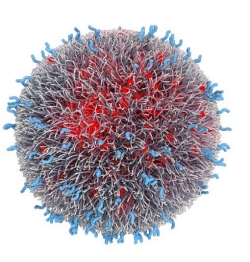Tiny Particles May Have a Big Impact on Treating Cancer

By Mona Simpson
Cancer is a general name for a group of more than 100 diseases that start off as abnormal growth cells that could potentially spread throughout the body, growing new tumors in other organs. This process is called metastasis. Metastasizing cancer cells change the sugars on the surface of each cell, avoiding immune detection. They do this by overproducing enzymes that add sialic acids to sugar chains. These sialic acids allow the cancer cells to detach from one organ and move to another without alerting the immune system.
Trial and Error
Years ago, researchers developed a drug to stop this critical change in sugars. The drug they developed is a sialic acid inhibitor known as P-3Fax-Neu5Ac. Unfortunately, scientists found that the drug is also lethal to animals. When researchers injected mice directly with this drug, the mice developed fatal kidney damage. In order for a drug to save lives, the drug should only target cancer cells.
Nanotherapy Could be the Answer
Now researchers have developed a new method to deliver the drug directly to cancer cells. The scientists used nanoparticles, objects so small that 800 of them could fit in the width of a human hair. These tiny particles can deliver the drug directly to cancer cells without damaging healthy cells. Research led by Gosse Adema, a tumor immunologist, packed P-3Fax-Neu5Ac into nanosized, biodegradable vesicles made from PLGA, a compound approved by the United States Food and Drug Administration (FDA). The mice that received the drug via nanoparticles had 75 percent fewer tumors than the mice that did not receive the drug. This is a promising start, but more testing will be needed.
Researchers will need to do more work to make sure that P-3Fax-Neu5Ac will work in humans the way that it has worked in mice. This is because the creation of sugar chains on cells, called glycosylation, is different in people than it is in mice. So this research may not directly provide a cure for cancer, but it does suggest a promising path for researchers to follow toward a cure for cancer in humans.
Extension Questions
- What is metastasis?
- What has been identified as causing cancer deaths?
- What was the problem researchers found with P-3Fax-Neu5Ac? How have they solved thisproblem so far?
- What is glycosylation?
- Do drugs that work in mice always work in humans? Why or why not?